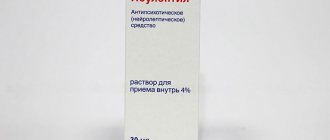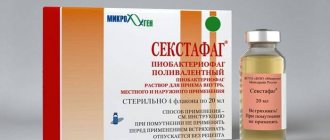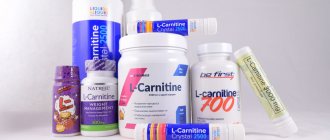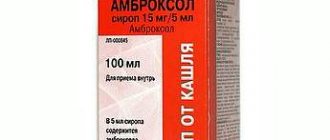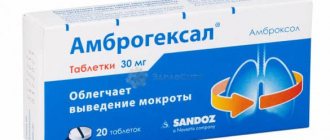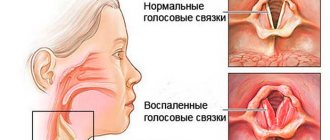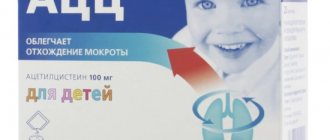Release form
Ambroxol (the instructions for use provide concise information about a number of release forms) is selected by a therapist or ENT specialist, depending on the patient’s age, the dynamics of the course and the severity of the disease.
| Release form | Content of active substance per unit Milligrams (MG) | Package |
| Tablets for oral administration (with liquid) | 30 | There are 10 pcs in a blister. In a cardboard package 1,2,3,4,5 blisters |
| Effervescent tablets | 60 | In a plastic bottle 10, 20 pcs. 1.2 bottles in a cardboard package |
| Extended release capsules | 75 | 1 blister 10 pcs. 1,2,5 blisters in cardboard packaging |
| Syrup | 15 mg/5 ml | Glass or polymer bottle 50, 100 ml |
| 30 mg, 5 ml | ||
| Oral drops (put in mouth) | 7.5 mg/ml 10 drops in 1 ml | 100 ml in a bottle with a dropper |
| 15 mg/ml 10 drops in 1 ml | ||
| Solution for inhalation | 7.5 mg/ml | 100 ml in a bottle with measuring cap |
| Injection | 15 mg/ml | 50, 100 ml in a bottle with a dosing syringe |
Ambroxol 7.5 mg/ml 4 ml 10 pcs. solution for oral administration and inhalation complete with solvent
pharmachologic effect
Expectorant, mucolytic agent.
Composition and release form Ambroxol 7.5 mg/ml 4 ml 10 pcs. solution for oral administration and inhalation complete with solvent
Solution - 1 amp.:
- Active ingredient: ambroxol hydrochloride – 7,500 mg;
- excipients: sodium chloride, sodium hydrogen phosphate dihydrate, citric acid monohydrate, benzalkonium chloride, purified water.
4 ml in a dropper tube with a valve.
50 ml, 100 ml in dark glass bottles with a screw neck, sealed with polyethylene dropper stoppers and screw caps with first opening control made of polymer materials.
Set:
10 dropper tubes of 4 ml with the drug, 10 dropper tubes of 4 ml with a solvent (Sodium chloride bufus, solvent for the preparation of dosage forms for injections 0.9%) with instructions for use are placed in a pack of cardboard for consumer packaging.
10, 15 dropper tubes of 4 ml each with instructions for use are placed in a pack of cardboard for consumer packaging.
A bottle of 50 ml, 100 ml with instructions for use and a measuring cup is placed in a pack of cardboard for consumer packaging.
Description of the dosage form
A transparent, colorless or brownish solution with a weak characteristic odor.
Directions for use and doses
Application of the solution internally (1 ml = 40 drops):
- adults and children over 12 years old: 4 ml (160 drops) 3 times a day;
- children from 6 to 12 years old: 2 ml (80 drops) 2-3 times a day;
- children from 2 to 6 years old: 1 ml (40 drops) 3 times a day;
- children under 2 years old: 1 ml (40 drops) 2 times a day.
Drops can be diluted in water, tea, juice or milk. The solution can be used regardless of meals.
Application of the solution in the form of inhalations:
- adults and children over 6 years old: 1-2 inhalations of 2-3 ml of solution per day;
- children under 6 years of age: 1-2 inhalations of 2 ml of solution per day.
The drug solution can be used using any modern equipment for inhalation (except steam inhalers). To achieve optimal hydration during inhalation, the recommended amount of the drug is adjusted to the 4-6 ml mark with a solvent (sodium chloride 0.9%) in the nebulizer container. Since during inhalation therapy a deep breath can provoke a cough, inhalations should be carried out in normal breathing mode. Before inhalation, it is recommended to warm the inhalation solution to body temperature.
Patients with bronchial asthma are recommended to carry out inhalation after taking bronchodilators to avoid nonspecific irritation of the respiratory tract and their spasm.
For children under 2 years of age, ambroxol is prescribed only under the supervision of a doctor.
Ambroxol should not be used for more than 4-5 days! If symptoms of the disease persist within 4-5 days from the start of treatment, it is recommended to consult a doctor.
Pharmacodynamics
Ambroxol is an active N-demethylated metabolite of bromhexine.
It has secretomotor, secretolytic and expectorant effects.
Stimulates the work of the bronchial glands, increases the motor activity of the ciliated epithelium by affecting type 2 pneumocytes in the alveoli and Clara cells in the bronchioles, enhances the formation of endogenous surfactant - a surfactant that ensures the sliding of bronchial secretions in the lumen of the respiratory tract. Ambroxol increases the proportion of the serous component in the bronchial secretion, improving its structure and helping to reduce viscosity and thin the sputum; as a result, mucociliary transport improves and the removal of sputum from the bronchial tree is facilitated.
On average, when taken orally, the effect of the drug occurs within 30 minutes, the duration of action is 6-12 hours, depending on the dose taken.
Pharmacokinetics
Suction. After oral administration, ambroxol is quickly and almost completely absorbed from the gastrointestinal tract. The maximum concentration (Cmax) in blood plasma is achieved after 1-3 hours. The distribution volume is 552 l. The absolute bioavailability of ambroxol when taken orally as a result of “primary passage” through the liver is reduced by approximately 1/3.
Distribution. Communication with blood plasma proteins is 80-90%. Ambroxol penetrates the placental and blood-brain barriers and is excreted in breast milk.
Metabolism. Ambroxol is metabolized in the liver by conjugation to form pharmacologically inactive metabolites.
Excretion. The terminal half-life from blood plasma (T1/2) is 7-12 hours. The total half-life of ambroxol and its metabolites is about 22 hours. The total clearance is within 660 ml/min. Excreted by the kidneys: 90% in the form of metabolites (such as dibromoanthranilic acid, glucuronides), about 10% unchanged. In case of severe renal dysfunction (creatinine clearance less than 30 ml/min), accumulation of ambroxol metabolites is possible; in severe liver failure, the clearance of ambroxol is reduced by 20-40%.
Due to the high degree of binding to plasma proteins and the significant volume of distribution, as well as the slow reverse distribution from tissues to the blood, effective elimination of ambroxol by dialysis or forced diuresis is unlikely.
Indications for use Ambroxol 7.5 mg/ml 4 ml 10 pcs. solution for oral administration and inhalation complete with solvent
Impaired secretion and transport of sputum in acute and chronic respiratory diseases: acute and chronic bronchitis, pneumonia, chronic obstructive pulmonary disease, bronchial asthma, bronchiectasis.
Contraindications
Hypersensitivity to the components of the drug, first trimester of pregnancy and breastfeeding, children under 2 years of age (used only as prescribed by a doctor).
With caution: impaired bronchial motility and increased mucus secretion (for example, in the rare syndrome of primary ciliary dyskinesia); renal failure and/or severe liver failure; peptic ulcer of the stomach and duodenum, including a history; II-III trimesters of pregnancy.
Application Ambroxol 7.5 mg/ml 4 ml 10 pcs. solution for oral administration and inhalation complete with solvent during pregnancy and lactation
The use of the drug in the first trimester of pregnancy and during breastfeeding is contraindicated. The use of the drug in the II-III trimesters of pregnancy is possible only after a careful assessment of the balance between the benefits of treatment and possible risks.
special instructions
During treatment, it is necessary to drink a lot of fluids (juices, tea, water), as this enhances the mucolytic effect of the drug.
Ambroxol should be taken with caution in patients with a weakened cough reflex or impaired mucociliary transport due to the possibility of sputum accumulation.
In patients with bronchial asthma, ambroxol may increase cough.
Mucolytic agents may have an irritating effect on the mucous membrane of the gastrointestinal tract, so ambroxol should be used with caution in patients with gastric and duodenal ulcers.
In patients with renal and/or liver failure, ambroxol should be taken only on the recommendation of a doctor, with longer intervals between doses or at a lower dose.
For children under 2 years of age, ambroxol is used only as prescribed by a doctor.
Ambroxol should not be taken simultaneously with antitussive drugs that impede the removal of sputum.
The solution contains the preservative benzalkonium chloride, which, when inhaled, may cause bronchospasm in sensitive patients with increased respiratory tract reactivity.
Ambroxol solution for oral administration and inhalation is not recommended to be mixed with cromoglycic acid and alkaline solutions. An increase in the pH value of the solution above 6.3 may cause precipitation of ambroxol hydrochloride or the appearance of opalescence.
Patients on a hyposodium diet should take into account that the drug contains 42.8 mg of sodium in the recommended daily dose (12 ml) for adults and children over 12 years of age.
There are isolated reports of severe skin lesions, such as Stevens-Johnson syndrome and Lyell's syndrome, coinciding with the administration of expectorants such as Ambroxol. In most cases, they can be explained by the severity of the underlying disease and/or concomitant therapy. Patients with Stevens-Johnson syndrome or Lyell's syndrome may experience fever, body pain, rhinitis, cough and sore throat in the early phase. With symptomatic treatment, it is possible to erroneously prescribe anti-cold medications. If new lesions of the skin and mucous membranes appear, it is recommended to stop treatment with the drug and immediately seek medical help.
After opening the dropper tube, use the drug solution within 48 hours.
Impact on the ability to drive vehicles and operate machinery
There were no cases of the drug affecting the ability to drive vehicles and machinery. Studies on the effect of the drug on the ability to drive vehicles and engage in other potentially hazardous activities that require increased concentration and speed of psychomotor reactions have not been conducted.
Overdose
Symptoms: nausea, vomiting, diarrhea, pain in the upper abdomen, heartburn, dyspepsia (indigestion). There are reports of short-term anxiety. In case of severe overdose, a significant decrease in blood pressure is possible.
Treatment: artificial vomiting, gastric lavage in the first 1-2 hours after taking the drug, taking fat-containing foods, symptomatic therapy. Due to the high degree of binding of ambroxol to plasma proteins and the large volume of distribution, hemodialysis or forced diuresis is not advisable.
Side effects Ambroxol 7.5 mg/ml 4 ml 10 pcs. solution for oral administration and inhalation complete with solvent
Immune system disorders - Rarely: hypersensitivity reactions, skin rash, urticaria; Frequency unknown: anaphylactic reactions (including anaphylactic shock), angioedema, pruritus.
Nervous system disorders - Common: dysgeusia (impaired sense of taste).
Respiratory, thoracic and mediastinal disorders - Uncommon: shortness of breath (as a sign of a hypersensitivity reaction); Frequency unknown: decreased sensitivity in the throat (numbness).
Gastrointestinal disorders - Common: nausea, decreased sensitivity in the mouth (numbness); Uncommon: dyspepsia, vomiting, diarrhea, abdominal pain, dryness of the oral mucosa and pharynx; Very rare: hypersalivation (excessive salivation).
Skin and subcutaneous tissue disorders - Frequency unknown: erythema multiforme exudative, Stevens-Johnson syndrome, toxic epidermal necrolysis (Lyell's syndrome), acute generalized exanthematous pustulosis.
General disorders and administration site conditions - Uncommon: fever.
Drug interactions
With the simultaneous use of ambroxol with antitussive drugs, it may be difficult to discharge sputum as a result of suppression of the cough reflex.
When used simultaneously with amoxicillin, cefuroxime, erythromycin, ambroxol increases their concentration in bronchial secretions.
Composition and mechanism of action
In all forms of release, the active substance is ambroxol hydrochloride. Excipients depend on the form.
Pills:
- Lactose monohydrate – the ability to be absorbed by the walls of the small intestine at low acidity in the gastrointestinal tract (gastrointestinal tract).
- Colloidal silicon dioxide : uniform absorption by the walls of the gastrointestinal tract; improved tablet slip.
- Magnesium stearate : mitigating irritation of the gastrointestinal mucosa, preventing the breakdown of the active substance at high acidity.
- Potato starch – protection against the effects of gastric juice.
Effervescent tablets:
- Glycerin – softens irritation of the gastrointestinal mucosa.
- Saccharin – accelerates absorption at low acidity.
- Propylene glycol – uniform absorption.
- Hydroxyethylcellulose – prolongation of action at high acidity.
- Menthol – eliminates nausea, thins the mucous membrane in the respiratory tract.
- Flavorings : citric acid, orange, apricot.
- Dyes - Sodium benzoate.
- Sorbitol – as an environmental preservative.
Capsules:
- Magnesium stearate.
- Acrylates – prolongation of absorption and elimination period of the active substance from the body.
- Titanium dioxide is an antioxidant (slows down oxidative processes).
- Red iron oxide – mild digestive stimulation.
Syrup:
- Saccharin.
- Glycerol.
- Propylene glycol.
- Food flavorings: citric acid, apricot, orange, menthol.
- Water.
Drops: 9% sodium chloride. Solution for inhalation and injection: purified water.
Pharmacological properties
Ambroxol hydrochloride:
- thins the mucous membrane of the respiratory tract;
- normalizes the functioning of the serous glands;
- stimulates the activity of the cilia of the ciliated epithelium - accelerating the movement of sputum;
- releases lysosomes from Clara cells - reducing viscosity and increasing oiliness of sputum;
- increasing the immune defense of the mucous epithelium of the respiratory tract;
- strengthening the cell membranes of pneumocytes, increasing their elasticity.
The period of reaching peak concentration in the body and the time of complete withdrawal of ambroxol hydrochloride depend on the form of release.
| Release form | Period to reach maximum concentration | Period of complete elimination from the body |
| Tablets for oral administration | 2 hours | 12 h |
| Effervescent tablets | 30 min. | 6 hours |
| Extended release capsules | 3 hours | 22 h |
| Syrup | 1 hour | 6 hours |
| Drops | 15 minutes. | 2-3 hours |
| Inhalation | 5 minutes. | Up to 30 min. after the end of inhalation |
| Intravenous injections | 10 min. | 1.5 h |
| Infusions | 15 minutes. | 12 hours after the end of the drip |
Instructions for use of Ambroxol indicate average values. The time to reach maximum concentration depends on the functionality of the liver; the period for complete withdrawal is from the kidneys and the permeability of the pores of the skin.
pharmachologic effect
Ambroxol is an active N-demethylated metabolite of bromhexine.
It has secretomotor, secretolytic and expectorant effects. Stimulates the work of the bronchial glands, increases the motor activity of the ciliated epithelium by affecting type 2 pneumocytes in the alveoli and Clara cells in the bronchioles, enhances the formation of endogenous surfactant - a surfactant that ensures the sliding of bronchial secretions in the lumen of the respiratory tract.
Ambroxol increases the proportion of the serous component in the bronchial secretion, improving its structure and helping to reduce viscosity and thin the sputum; as a result, mucociliary transport improves and the removal of sputum from the bronchial tree is facilitated.
Indications
Ambroxol syrup, internal solution and drops can be taken from 2 years of age. Inhalation should be done only after reaching 5 years of age. Capsules and tablets for oral administration from 12 years of age. Effervescent tablets from 16 years of age.
Taking syrup solution for internal use, drops up to 2 years, inhalation up to 5 years, tablets and capsules up to 12 years, effervescent tablets up to 16 years - only as prescribed by a doctor. Ambroxol (the instructions for use contain a number of indications) is recommended to be taken for various diseases and conditions of the body.
For example:
- Acute bronchitis with paroxysmal cough.
Ambroxol is used for severe cough and bronchitis. - Chronic bronchitis with prolonged cough for 2 weeks. and longer.
- Pneumonia.
- Exudative pleurisy; before collecting fluid for transudative pleurisy.
- Respiratory distress syndrome.
- Respiratory distress syndrome due to accumulation of viscous mucus.
- Diseases of the upper respiratory tract, accompanied by thickening of the nasopharyngeal mucosa.
- Rhinitis; vasomotor only after swelling decreases.
- During the recovery period after lung surgery.
- With some antibiotics in the treatment of diseases of the upper and lower respiratory tract to enhance the effect of antibacterial agents.
- In combination during the course of the flu.
- After passing through the stage of exacerbation of other viral diseases, if there is a dry cough.
For what cough should I take it?
Many potential and actual patients do not always understand in which case of cough this drug should be taken. The instructions state that it is rational to use the product in case of infectious and inflammatory processes of the pulmonary system. After all, it is for this reason that a cough occurs, which is called non-productive (dry). If the accumulated exudate starts to be released, the cough reflex becomes wet. Many people do not see the difference between the two types of phenomena, so the question: which cough to take is relevant.
Ambroxol tablets, solution and syrup are used for the prevention and treatment of respiratory distress syndrome in newborns and premature infants, as well as to stimulate prenatal lung maturation.
Contraindications
The instructions indicate general contraindications, based on the action of the active and excipients. When prescribing drugs, doctors are guided by the results of complex diagnostics and the dynamics of the disease that causes cough and rhinitis.
Contraindications:
- Allergy to 1 or more components for this formulation.
- Damage to the gastrointestinal mucosa (ulcers, gastritis, colitis) - oral forms are not allowed.
- Age : effervescent tablets up to 16; extended-release tablets and capsules up to 12; inhalations up to 5; drops, syrup up to 2; injections and infusions at any age only as prescribed by a doctor (symptomatic treatment).
- Helminthiasis - asphyxia is possible with a high concentration of larvae or adults in the respiratory tract.
- Exudative pleurisy - with caution only as prescribed by a doctor; transudative - only under medical supervision.
- Chronic respiratory diseases with a duration of more than 3 months.
- Diabetes mellitus - with caution for forms with saccharin.
- Renal failure – prolongation of the excretion of metabolites (decomposition products) of drugs. Increased blood sugar and urea levels.
- For tablets, galactosemia , dysbacteriosis with an excess of lactobacilli; for all forms, except solutions, flatulence, constipation - difficulty breaking down fructose in flavorings. Slow absorption of saccharin, deposition of glycerol on the walls of the large intestine.
- 1st trimester of pregnancy.
- Do not use to thin sputum caused by chemicals.
Ambroxol is not an antipyretic; on the contrary, while taking the drug, body temperature can rise to 38 and above - activation of the immune system. If the cough is caused by a viral infection, do not lower the temperature and continue taking Ambroxol. If it exceeds 38.5, knock it down with ibuprofen or Nurofen. Medicines with acetylsalicylic acid are not allowed until the age of 16.
Ambroxol and its analogues
The active ingredient Ambroxol is disguised under different brands:
- Ambrobene;
- Lazolvan;
- Orvis Broncho;
- Thoraxol;
- Asterisk Broncho;
- Halixol.
Knowing the name of the active substance, it is easier to find a cheap analogue in the pharmacy, so as not to spend unreasonably large sums on the same thing, but under a different name.
Ambroxol, like drugs under other trade names, is sold in different forms: from tablets to solutions that are taken orally or used as an additive to an inhaler.
Side effect
A high frequency of adverse events is observed in children under 12 years of age. The main reason is the use of an inappropriate release form. The main manifestation is an allergy to 1 or more components. There is a high probability of allergies to multicomponent syrup, capsules, tablets. Low – for solutions.
Main manifestations: skin rashes, severe itching; swelling of the face, less often of the limbs; anaphylactic reactions.
If the allergy is caused by the oral form, rinse the stomach immediately; solutions, regardless of the method of application - cleansing infusion.
Other side effects:
- Diarrhea – normalize the composition of bile – phospholipid preparations.
- Dyspepsia - change the release form.
- Nausea is a strong simultaneous release of gastric juice and bile.
- Anti-inflammatory decoctions: 1 tsp per 0.5 liter of boiling water. chamomile, corn silk, immortelle; boil the composition for 3 minutes; can be taken at any age; decoction of flax seeds - 0.5 liters of cold water, 25 g of flax seeds, boil the composition for 10 minutes.
- Headache, weakness - give preference to beetroot dishes, blood sausage, hematogen; for children under 12 years old, add a minimum of garlic to blood sausage, exclude pepper.
- Activation of fungal diseases - antifungal (for children - Nystatin); folk remedies for external use only: for 3 liters of water, 15 large leaves of horseradish, a glass of dry onion peel; boil the composition for 15 minutes. over low heat; add 1.5 cups of finely chopped plantain; turn off the stove and leave the product for 24 hours; strain the mixture, heat it and take a bath; then rinse the limbs with water.
Side effects
Treatment with the drug may be accompanied by unwanted side reactions. It can be:
- dry mouth;
- nausea;
- vomit;
- constipation;
- diarrhea;
- stomach ache;
- allergic rash on the skin;
- skin itching;
- dry mucous membranes;
- rhinorrhea.
In rare cases, angioedema occurs. Anaphylactic shock can occur extremely rarely. Features of taking Ambroxol can be taken by women who are breastfeeding. The drug passes into breast milk in small quantities. But no negative effects of this medicine on infants have been identified.
It is not advisable to combine this medicine with codeine and similar cough suppressants. If the drug is taken in parallel with antibiotics, they, under its influence, accumulate in the lungs. At the same time, the activity of the antibiotics themselves increases.
Overdose
It is important to take Ambroxol (the instructions for use contain daily or course dosages) in the proper release form, since accelerated absorption (absorption) creates a short-term excess of concentration with the manifestation of general symptoms of overdose.
In addition to increased side effects, the following are also observed:
- Significant swelling of the mucous membrane of a non-allergic nature - you need to urgently call an ambulance. You should drink a lot, gargle with the mixture prepared according to the recipe: take 0.5 tsp per 200 ml of boiling water. St. John's wort, chamomile, boil for 1 minute; strain the mixture, add tsp at the tip. salt; Place the container in cold water.
- Decreased blood clotting levels – preparations with vitamin K; more foods with vitamin E: pumpkin, dill seeds, buckwheat and millet porridge, blood sausage, season salads with sunflower oil, carrots with sour cream.
- White plaque on the tonsils is the development of fungi. It is necessary to reduce the dosage, do not use antifungal rinses on your own, since there may be allergies, irritation or inflammation of the mucous membrane.
- Microthrombi - injections, infusions.
- Dysbacteriosis 1st, 2nd degree – tablets, capsules, syrup.
Ambroxol for inhalation in a nebulizer for adults
The approximate dosage for adults is 2-3 ml of the drug. In the first days, inhalations are done 3 times a day, then the frequency of respiratory procedures is reduced to 1. The duration of the course depends on the severity of the disease. Dilute with saline to make 4 ml of the finished medicine. You should breathe until the drug evaporates.
During pregnancy, the use of the drug and procedures are permitted. However, treatment should be carried out under the supervision of specialists. If side effects occur, therapy is stopped .
Video instructions for use
Mode of application
The maximum permissible daily dosage of ambroxol hydrochloride:
- 90 mg for adults.
- 45 mg for children 6-12 years old, with a calculation of 4.5 mg/kg divided into 3 doses from 2 to 6 years.
- For respiratory failure syndrome, infusion or intravenously at a rate of 10 mg/kg, regardless of age. Single entry.
- In case of acute symptoms, it is permissible to increase the daily dosage by no more than 1.5 times for no longer than 3 days. If there is no improvement in general condition within 5 days, stop taking it.
- If there are no clinical deviations during therapy, the average daily dosage is reduced by 1.5 times, starting from 5 days. The maximum duration of therapy is 14 days.
Features of use for children
Up to 12 years only syrup in the form of 15 mg/5 ml:
- 5-12 years: 5 ml 3 times a day.
- 2-5 years – 2.5 ml three times a day.
- Up to 2 years (as prescribed) – 2.5 ml twice a day.
In the first 2-3 days - double single dosage. Take after meals. The minimum single dosage is ½ measuring cup.
To prepare inhalation, use a 9% sodium chloride solution. Sold in a pharmacy - solution for inhalation, saline solution. Inhalation is best done using a nebulizer (a device with an aerosol injection function). Dilute with sodium chloride in the following proportions: 2-5 years 2 ml per 2 ml; 5-12 years – 3 ml per 3 ml. Do no more than 2 procedures per day. If you had to skip the procedure, give syrup.
Drops – 7.5/10 drops:
- Up to 2 years: 3 drops 2 times a day.
- 2-5 years – 5 drops 2-3 times a day.
- 5-12 years – 10 drops 3 times a day.
Solution for injection 1.5 mg/kg. For injections, dilute with 9% saline solution, for infusions - saline solution or dextrose. Release forms are produced by different manufacturers.
The initial age for using inhalation can vary between 2-6 years. To minimize side effects, inhalations should be used only as prescribed by a therapist, otolaryngologist, infectious disease specialist, or pediatric pulmonologist.
Azt Long and Ambroxol: which is better
ACC is based on the substance acetylcysteine, which, like Ambroxol, improves the rheological properties of sputum: it accelerates its production, reducing viscosity. The ciliated epithelium of the respiratory tract instantly reacts to the irritant, provoking a cough. A drug with the prefix “Long” indicates that the effect of a single dose is prolonged up to 12 hours. This means you need to take it in the morning, once a day. Taking Azz Long at night will cause the patient to have a cough that will suffocate him all night, preventing him from falling asleep.
When choosing between ACC and Ambroxol, you need to rely on the convenience of the release form for the patient and individual intolerance to the components.
Interaction with other drugs
When taken together with other drugs, the following changes in properties occur:
- Enhances the effect of natural antibiotics with fungal microorganisms - penicillins, cephalosporins.
- Increases the effectiveness of some semi-synthetic antibiotics: Erythromycin, Amoxicillin, Doxycycline, Cefuroxime.
- Reduced effectiveness with Flemoxin, increased toxicity of Macrolide.
- With antitussive drugs - a decrease in the effectiveness of both drugs, stagnation of the mucous membrane - transudative pleurisy.
- Syrup with probiotics and prebiotics causes flatulence.
- Reduced effectiveness of Rosuvastatin.
- Prolongation of theophylline withdrawal, increasing its toxicity.
- Do not mix in the same syringe with drugs whose pH is below 6.3 - a decrease in the effectiveness of Ambroxol, early salt deposition, and a slowdown in phospholipid metabolism.
Increased concentrations of Rifampicin in the lower respiratory tract - combined use is recommended.
Ambroxol analogues
The medicine has a lot of means that can replace it. Thus, in terms of the active substance, the drug has the following analogues: syrups “Ambrobene”, “Ambrohexal”, “Ambrolan”, “Ambrosan”, “Lazolvan”, “Flavamed”, “Ambrolitin”, “Medox”, “Mukolvan”, “Lazolex” and others. Therefore, if the pharmacy does not have the drug Ambroxol, the pharmacist can offer another drug that will be exactly the same in effectiveness. However, parents should be aware that the drug to which the article is devoted is the most budget-friendly option for syrups for bronchitis, pneumonia and prolonged cough.
special instructions
Ambroxol (the instructions for use recommend that patients with diabetes take the syrup due to the presence of sorbitol in the equivalent of 1 bread unit per 5 ml of syrup) in syrup form contains saccharin. Use only as directed, regardless of the type and stage of diabetes.
Do not put syrup or injection solution into a nebulizer or other inhaler. Drops - only if the concentrations per 5 ml are the same. Do not change your breathing rhythm during inhalation. If you have a coughing attack, interrupt the procedure, clear your throat, and resume inhalation. The amount of solution and the time of application do not change.
For liver problems, the period to reach maximum concentration increases. Depending on the degree of damage to hepatocytes (liver cells). For serious pathologies - drops and inhalation. If cramps occur during the procedure, 5-10 minutes before. Before the procedure, take a bronchodilator or use an inhaler. For bronchial asthma in 20-30 minutes. before the procedure.
In the 1st trimester of pregnancy, use only under medical supervision if the benefit outweighs the harm to the mother and fetus. Despite penetration into mother's milk, the manufacturer does not classify the lactation period as a contraindication.
Children with a weakened cough reflex should take the medicine only under hospital supervision, since asphyxia (suffocation) due to the accumulation of sputum is possible.
Do not do breathing exercises throughout the entire course. Do not expose the body to contrasting changes in temperature and air humidity. Before walking outdoors in winter, put on a gauze bandage to prevent sudden hypothermia of the respiratory tract or cover your nose with a scarf. Walk slowly. If your breathing quickens, immediately go into a warm room.
If you have bronchial asthma or severe paroxysmal cough, do not take the drug before bed. If you have severe headaches while coughing, then you need to consult a doctor, reduce the dosage or switch to a release form with a stable maintenance of the concentration of Ambroxol - tablets, capsules.
For rhinitis, instill oral drops into the nose according to a similar scheme. If there is a burning sensation, immediately apply oil drops and stop using Ambroxol.
Do not take under any circumstances without consulting a doctor under the following conditions:
- Autoimmune diseases.
- During and after therapy with non-steroidal anti-inflammatory and/or glucocorticosteroids.
- Aching bones at normal body temperature.
- Untreated or progressive fungal diseases - candidiasis (also in remission), mycosis, onychomycosis, lichen (regardless of the cause and origin).
- Fragility of blood vessels, brittle bones, unhealed fractures - only drops, inhalations.
Can children take Ambroxol?
Infants during the neonatal period (the first 28 days of life) and before reaching the age of two do not have the full ability to cough. Their reflex function of mucus rejection is reduced, and the shocks of exhaled air when coughing are not powerful enough to remove phlegm. Therefore, children under two years of age should not be given mucolytics.
Increased mucus production while taking Ambroxol will cause its accumulation in the lower parts of the lungs and bronchi, which will lead to the addition of a secondary bacterial infection, which will develop pneumonia.
In this connection, taking the drug in syrup form is indicated only for those patients who have already learned to cough - over 2 years of age.
Use for dry cough
Depending on the course of concomitant diseases, symptoms and duration of cough, and medications taken, different regimens for taking Ambroxol are used.
For example:
- Sputum does not come out, in the lungs when coughing there are sounds of a large accumulation of liquid - inhalation for 5 days, syrup for 6-14 days.
- There are pains in the lungs, there is no urge to cough, there is wheezing in the lungs - antibiotics interact with Ambroxol; Ambroxol intramuscularly 2 times, syrup.
- There are no wheezing or sounds of fluid accumulation in the bronchi, a strong urge to cough, itching - an urgent diagnosis.
- Dry cough and dry mouth - drops.
Ambroxol can be used independently, regardless of age, only for the second time, to speed up the process of sputum discharge after an illness. In other cases, only as prescribed by a doctor. For children - only for their intended purpose.
Ambroxol syrup analogues
In cases where Ambroxol cannot be used, analogues of the drug come to the aid of doctors. There are many drugs with similar active ingredients and mechanisms of action. When the doctor notes the lack of effect from using Ambroxol for children or a reaction to the drug appears, a replacement is made. In this case, the dosage, frequency of administration and duration are calculated again.
Among the many analogues of Ambroxol, the following drugs with a similar composition and therapeutic effect can be distinguished:
- Ambrobene;
- Lazolvan;
- Ambrohexal;
- Halixol;
- Flavamed.
Storage conditions and shelf life
All release forms have the same storage conditions: temperature 15-25 degrees without access to light. Shelf life is 3 years, and for effervescent tablets 5 years.
After opening the package, bottle with solution, syrup:
- Tablets, capsules – 1 year.
- Syrup – 30 days.
- Drops and solution for inhalation – 60-90 days, depending on access to light.
- Solution for injection: 6 hours; diluted with dextrose in a drip system – 4-6 hours.
The synthetic drug Ambroxol serves to thin and accelerate the removal of viscous mucus from the respiratory tract. The drug is available in several forms. Based on the instructions for use and the results of several diagnostic methods, you can choose the most suitable option for children.
To reduce the likelihood of side effects, take for the first time as prescribed by a doctor or after his approval.
Article design: Oleg Lozinsky
Pharmacological effect
Ambroxol is a mucolytic that allows you to quickly and effectively remove phlegm from the respiratory system. The chemical composition is absolutely safe, so the risk of side effects is minimal. Thanks to the use of ambroxol, the work of the villi of the respiratory tract is activated. This ensures rapid release of surfactant by the lungs. Due to these processes, it is possible to quickly liquefy mucus, stimulate its removal from the body and stop coughing.
This tool is characterized by the following features:
- The drug activates the lungs' secretion of surfactant, a protective factor. Due to this, it is possible to achieve effective protection of the tissues of the respiratory organs.
- The basis of the drug is ambroxol hydrochloride. It is a metabolite of bromhexine and is non-toxic.
- When using the drug, it is possible to reduce the viscosity of sputum. Thanks to this, you can make the mucus more liquid and successfully remove it from the body.
- The product strengthens the immune system and improves the penetration of antibacterial agents into the lungs. That is why ambroxol is often combined with antibiotics prescribed by a doctor.
The complex use of the product is highly effective and helps not only to quickly eliminate cough, but also to cope with the source of pathology.
Pharmacological properties
Pharmacodynamics
According to studies, the effect of ambroxol, the active component of Ambroxol-SOLOpharm, is aimed at increasing secretion in the respiratory tract. It enhances the production of pulmonary surfactant and has a stimulating effect on ciliary activity. Due to this, the flow and transport of mucus (mucociliary clearance) increases, which in turn leads to improved sputum discharge and cough relief.
Long-term therapy with ambroxol (for at least 2 months) against the background of chronic obstructive pulmonary disease provides a significant reduction in the number of exacerbations. There was a significant decrease in the number of days of antibiotic therapy and the duration of exacerbations.
Pharmacokinetics
All dosage forms of immediate release ambroxol are characterized by rapid and almost complete absorption from the gastrointestinal tract, and there is a linear dose dependence in the therapeutic concentration range. When taken orally, Cmax (maximum concentration of the substance) in the blood plasma is reached in 1–2.5 hours. Vd (volume of distribution) – 552 l. Binding of the substance to plasma proteins in the therapeutic concentration range is approximately 90%.
When administered orally, there is a rapid transition of ambroxol from the blood to the tissues, with the highest concentrations of the substance observed in the lungs. About 30% of the dose is affected by first pass through the liver.
According to studies on human liver microsomes, the predominant isoform responsible for the metabolism of the active substance to dibromanthranilic acid is the CYP3A4 isoenzyme. The remainder of the dose is metabolized in the liver, primarily by glucuronidation and partial breakdown to dibromoantranilic acid (approximately 10% of the dose), as well as a small number of additional metabolites.
Terminal T1/2 (half-life) of the substance is 10 hours. Total clearance is within 660 ml/min, renal clearance is approximately 8% of the total clearance. It is estimated (using the radioactive tracer method) that after taking a single dose, approximately 83% of the dose is excreted in the urine over the next 5 days.

